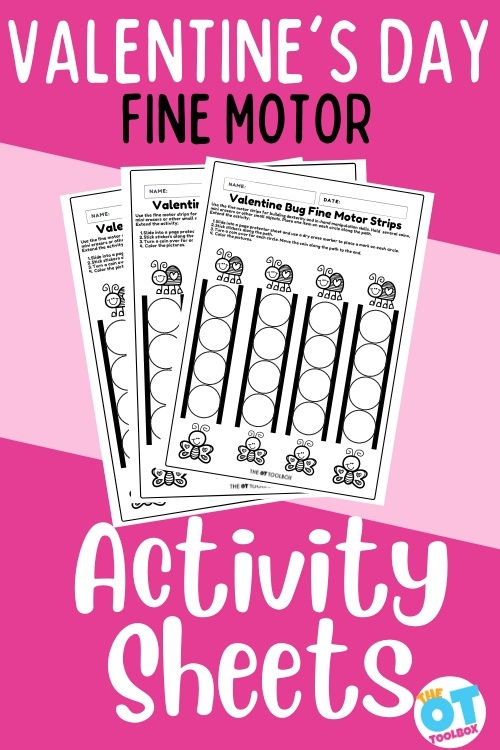Helping kids develop and strengthen fine motor skills is essential for functional tasks, and this resource on fine motor precision activities supports that development. Here, we are addressing what fine motor precision means and specific activities to do with kids to help with grasp manipulation, dexterity, and graded movements like managing a zipper, buttons, and adjusting a pencil within the fingers to write and erase. These are just a few examples of how grasp and release activities support fine motor skill development. Let’s break this down…
Fine Motor Precision Activities
Before we get to the fun stuff…the actual fine motor activities that support graded grasp and release, manipulation of objects within the hand, and various amounts of pressure and precision needed to perform functional tasks, let’s cover exactly what precision skills look like, what the term means, and why this area of development is so important.
At the bottom of this post, you’ll find specific strategies to support precision development so that kids can complete these tasks and not fumble with objects in the hands.
A good place to start is with our resource listing games with paper clips as a tool to support precision and refined dexterity.
This post is part of my 31 Days of Occupational Therapy series where you can find 30 more ideas like this one with easy treatment materials.
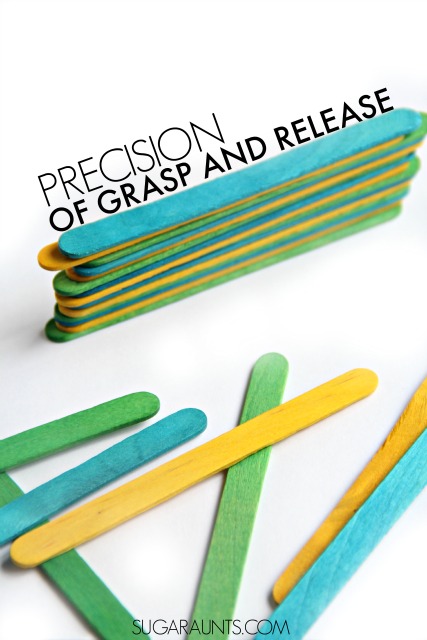
What is Fine Motor Precision?
Fine Motor Precision refers to the ultra-fine motor skills in the hand, broken down into areas: grasp and release, fine motor rotation, in-hand manipulation, and proprioception. Together, these precision skills enable us to pick up an object with the right amount of pressure and motor dexterity so you can grasp the object accurately taking eye-hand coordination skills into consideration. After grasping the object without overshooting or missing the item, it is necessary to position or rotate the object within the hand
Let’s cover each of those areas in greater detail below.
But first, it’s important to note that a child’s ultra fine motor dexterity is dependent on bigger things. And by that, I mean that in order for a child to use their hands super fine motor tasks, they first must demonstrate strength and control of their core, shoulder, and arm. If any of these areas are not fully developed in stability or control, then the child will show compensatory strategies as they try to use their hands in handwriting or cutting with scissors. Gross motor coordination is a great place to start if precision skills seem to be “off” or delayed. Related to that is the key input of body awareness and the impact of heavy work on more distal motor coordination skills.
One way to remember this is this:
“Proximal stability allows for distal mobility.”
Colleen Beck, OTR/L
Before a child can manipulate and move an object with dexterity and refined motor skills, there needs to be a base of support in stability in the core and upper extremity, mobility and coordination in the proximal joints (shoulder before elbow…elbow before wrist…and wrist before hand).
Breaking it down further, arch development and strengthening of the intrinsic muscles in the hands are both areas that are essential for precision in the fingertips.
The following resources will be a great way to break these areas of development down:
- Upper extremity strength
- The OT’s Guide to Fine Motor Skills
- Wrist stability
- Lateral pinch
- Types of pencil grasp patterns
Fine Motor Precision
Kids and fine motor skills go hand-in-hand. (That is my funny-OT attempt at a fine motor skills joke!) But really, fine motor skills are a staple of a child’s development and are essential to function.
Precision occurs with development of grasp when child to use the pads of the index finger, middle finger, and thumb to manipulate objects with opposition. I talked a little about strengthening these types of grasp patterns.
Today, I’m sharing ways to work on the controlled use of these fine motor patterns in controlled dexterity tasks. The precision of grasp and release is essential for very small motor movements in activities like picking up beads and releasing items like blocks with precision. This is broken down into areas of dexterity that all work together:
- Grasp and release (we’ll break these two areas down even further)
- Fine motor rotation
- In-hand manipulation
- Muscular force, or the amount of force applied through the muscles in small motor use, also referring to proprioceptive input through the hands and fingers.
What is precision of grasp and release?
Precision in grasp, manipulation, and release of small objects makes the difference between fumbling with zippers and buttons and efficiently grading movements in very small dexterity patterns like threading a string through a needle (kid-friendly, of course!)
Precision in grasp is related to the picking up of items. A graded lateral grasp is needed to cut with scissors and only squeeze the scissors halfway shut for accurate cutting lines in some situations. Around 3-4 years, a preschool aged child typically develops a greater variety of grasping patterns, including precision. They begin to grade their scissor strokes so that they can cut a line or shape without opening and closing the scissors completely. Grasps in babies typically begin with a raking motion and work towards a pincer grasp. Precision in this skill occurs when the child is able to pick up very small items like beads with accuracy and graded movements.
Precision release is needed for stacking blocks without toppling them over, placing cards on a pile, opening scissors just a small amount, or placing small beads into a bowl. Precision is needed for a child to let go of an item in a controlled manner. If they are not exercising precision in release, you might see them rolling or tossing an object as they let go. They will knock over a stack of blocks, or over open the scissors when cutting lines, making their accuracy very choppy.
Precision in rotation is another task that children develop around age 5. Rotation is a portion of in-hand manipulation and seen when turning a coin on the edges and the child rotates it in a circular motion. Precision in rotation also occurs when holding a pencil between the fingers and the child rotates it over and over.
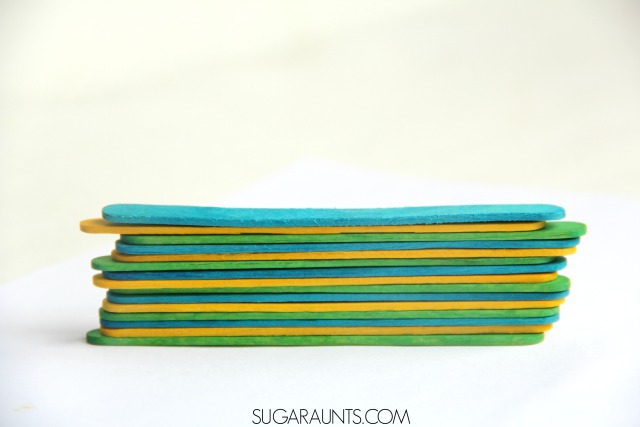
One way to develop these skills is through practice! One precision grasp and release activity I love is using popsicle sticks in various colors. You can stack the popsicle sticks so they build a wall without toppling over. Using the different colors allows kids to see how the sticks are aligned by offering contrasting colors. If they see a bit of yellow stick under the green stick, then they need to adjust the top stick with refined motor movements.
Grade this activity for younger kids or those developing skills:
- Simply place a single popsicle stick down on a table surface. Then pick it up.
- Younger kids can stack just one stick on top of another.
- Match colors.
- Make a wall of popsicle sticks to develop more refined precision skills.
- Place and sort popsicle sticks into a container on the vertical position (shown below)
To practice precision in grasp and release, I showed my preschooler how to pick up and stack Popsicle sticks. Picking up the sticks required a tip-to-tip grasp. We used different colored Popsicle sticks for my 4 year old and my 17 month old.
The preschooler was able to pick up the sticks accurately without pushing other sticks around. She could grasp the specific stick she wanted by an end or middle accurately.
The toddler grabbed the sticks with a pincer grasp, but showed much less accuracy.
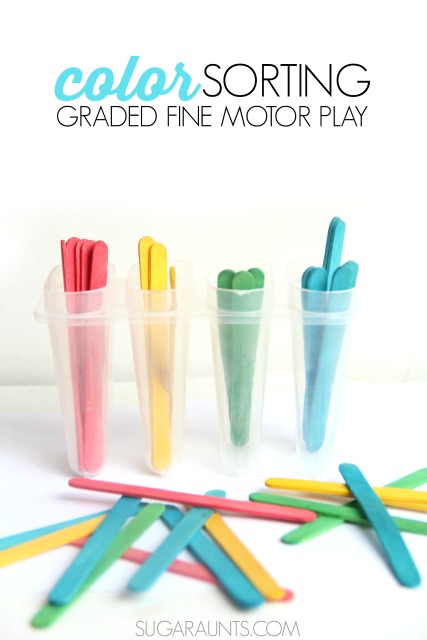
To advance this popsicle stick sorting, the next step is precision in rotation. This can be addressed by asking the individual to sort popsicle sticks into containers.
Different small cups (Dixie cups would work) but we used a popsicle mold to encourage a single hand to hold the mold as the assisting hand.
We used an empty Popsicle mold to place the sticks into the cups. What a great way to practice grasp precision! We worked on sorting the craft sticks by color and had to hold the mold with one hand to work on bilateral hand coordination. For the activity, we placed the mold on the floor and sorted the colored sticks without knocking the Popsicle mold over. Both the preschooler and the Toddler loved this simple activity.
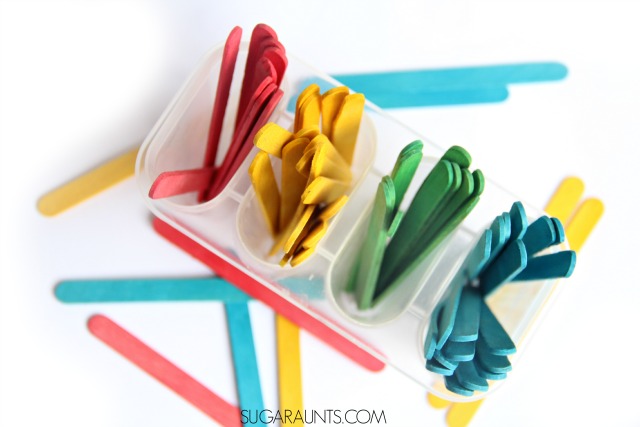
Another precision in release activity was simply stacking the craft sticks. The four year old could do this, but used her non-dominant hand to stabilize.
Precision in in-hand manipulation- In hand manipulation skills include different components as well. In our blog post, we cover rotation, refined movements within the hand, and how to actually move objects from the fingertips to the palm and ice versa. These are precision skills at work!
Muscular force- This refers to knowing how much force to use to pick something up. When it comes to muscular force in fine motor skills this can mean the difference between overshooting an object when picking something up, fumbling with small objects, pinching things with too much force, or dropping items because not enough force is applied.
As described above, muscular force also refers to the amount of force applied through the muscles in small motor use, also referring to proprioceptive input through the hands and fingers. Another term for this concept is force modulation, or graded force.
Muscular force is a must for picking objects up, putting them back down, manipulating them within the hand, and rotation.
We go into greater detail on the proprioceptive input in our blog post on proprioception. In summary, muscular force means the ability to inherently know how much force is needed to pick up and hold and manipulate a ladybug as opposed to a heavier rock. Too much force and the bug is squashed. Not enough force, and the rock slips through the fingers. Another example is pressing too hard when writing and holding a pencil. This experience and muscle knowledge happens through play!
As you can see, all of these concepts work together to enable precision skills in functional tasks!
Precision Activities
We’ve covered a couple of precision activities related to grasp and release and rotation, but let’s go over a few more that include all aspects of precision, including muscular force activities and how these are related to functional participation.
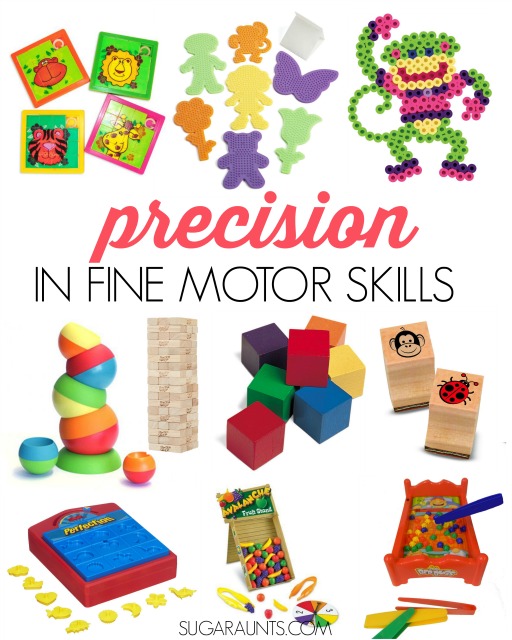
This post contains affiliate links.
Looking for more ways to practice precision in grasp, release, and rotation with Occupational Therapy students or your kids? Try some of these ideas. While they are not all free (going with our series this month!), they are creative ways to practice precision.
- Pick-up sticks- Try this DIY Pick-Up Stick Activity to work on Precision Skills.
- Pick up and place money on a table surface
- Stack coins
- Tong and tweezer activities
- Put paper clips onto paper
- Play games with paper clips
- Handwriting Warm Up Exercises
- Lacing cards- Try these Homemade Lacing Cards
- Motor Planning Fine Motor Maze
- Hand Strengthening Building Activity
- Precision engineering activities that use play dough and blocks to work on force modulation in the hands as well as eye-hand coordination.
- Small motor pegboards like this precision pegboard activity combining crafts with fine motor skills
- Perler beads- Try manipulating Perler Fuse Beads with Pegboards (affiliate link) for precision in grasp and release. These pegboards are very small and work on very fine dexterity with precision.
- Stamp sets (affiliate link)- Playing with stamps is a good way to practice graded grasp and release. Use these stamp blocks to accurately stamp within a specific area on a page. Draw squares or circles and the child needs to stamp in those areas.
- Tweezer games and activities like this Bed Bugs Game (affiliate link) encourage a precise and graded grasp and release of the small game pieces using tweezers. This game is on my must-buy list for Christmas this year!
- This Avalanche Fruit Stand (affiliate link) for another fun way to practice precision with a pair of tweezers. Stack the fruit with precision of grasp and release in a fun and colorful way!
- The Perfection Game (affiliate link) is another game that is great for precise grasp and release. Encourage kids to rotate the pieces by twirling the peg of the game pieces to work on precision in rotation as well.
- Jenga (affiliate link) is a precision work out in grasp and release of the blocks. My kids love this game!
- Stacking blocks is a precision pattern activity that is perfect for working on graded grasp and release.
- This Tobbles stacking toy (affiliate link) is a version of that, with bright and bold colors. Try stacking and taking these balls down without knocking them over!
- Sometimes, simple is best! These Wooden Color Cubes (affiliate link) are perfect for simple block building and stacking while working on precision of grasp and release.
- Kids need precision of the thumb, too. These Slide Puzzles (affiliate link) are not only fun, they work on small motor skills needed for graded movements in cutting and pencil control.
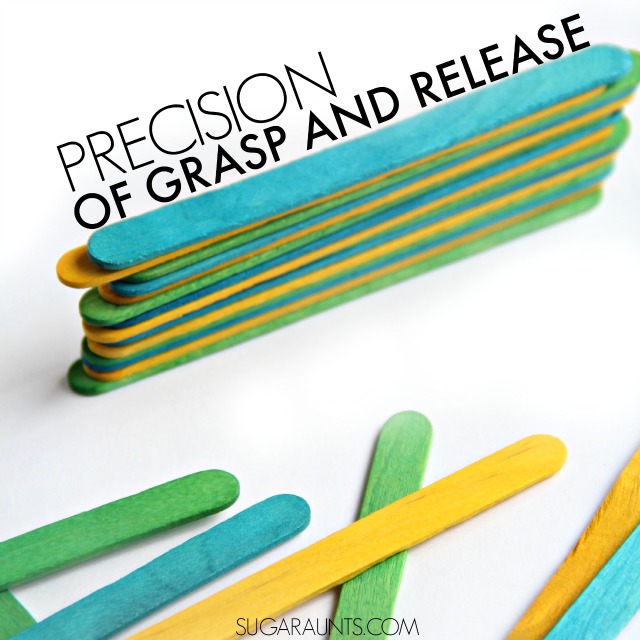
It’s my hope that this post and ideas were helpful and a resource for you! Looking for more fine motor activities for functional grasp? Try these:
Working on fine motor skills, visual perception, visual motor skills, sensory tolerance, handwriting, or scissor skills? Our Fine Motor Kits cover all of these areas and more.
Check out the seasonal Fine Motor Kits that kids love:






Or, grab one of our themed Fine Motor Kits to target skills with fun themes:
- Frogs Fine Motor Kit
- Unicorns Fine Motor Kit
- Vehicles Fine Motor Kit
- Apple Fine Motor Kit
- Back to School Kit
- Sports Fine Motor Kit
- Outer Space Fine Motor Kit
- Fairytale Fine Motor Kit
- Plus more in our shop!
Want access to all of these kits…and more being added each month? Join The OT Toolbox Member’s Club!

Colleen Beck, OTR/L has been an occupational therapist since 2000, working in school-based, hand therapy, outpatient peds, EI, and SNF. Colleen created The OT Toolbox to inspire therapists, teachers, and parents with easy and fun tools to help children thrive. Read her story about going from an OT making $3/hour (after paying for kids’ childcare) to a full-time OT resource creator for millions of readers. Want to collaborate? Send an email to contact@theottoolbox.com.


